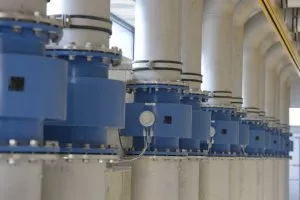Acompanhar indicadores de forma contínua é essencial para evitar que grandes problemas passem despercebidos e para buscar a otimização de performance. Essa prática se aplica a qualquer área de uma empresa. Levando isso em conta, o objetivo deste artigo é abordar especificamente a criação e a análise de um parâmetro característico do uso de recursos hídricos dentro de uma indústria. Embora o foco seja o ramo de bebidas, a abordagem pode ser aplicada a qualquer tipo de ambiente de produção.
Em uma indústria de bebidas, um dos principais indicadores de otimização de uso de água é o litro por litro (L/L):
Eficiência=〖Litros 〗_(água captada)/〖Litros 〗_(produto final)
Como a fórmula implica na quantidade de água utilizada por litro de bebida produzida, ela permite avaliar a eficiência do processo de produção, identificar oportunidades de otimização e economia, e facilitar a comparação entre lotes e produtos.
Porém, calcular esse indicador nem sempre é uma tarefa fácil, especialmente quando se deseja um acompanhamento diário. Fatores como caixas d’água, estações de tratamento e picos de produção geralmente trazem complexidade ao processo de cálculo, exigindo um levantamento técnico detalhado. Isso é necessário para evitar a geração de informações incorretas que podem levar a decisões equivocadas. Além disso, de acordo com a CNI (Conselho Nacional da Indústria), no material “Uso da água no setor industrial brasileiro”, outro fator que ressalta essa dificuldade é a limitada disponibilidade de dados sobre o uso da água no setor industrial, o que constitui um obstáculo para a efetiva caracterização das indústrias em termos de consumo desse recurso (FERES et al., 2005).
Estratégias para Avaliar Indicadores de Uso de Água na Indústria
Para fazer o levantamento da trajetória hídrica na indústria, a primeira etapa é montar um mapa completo indicando onde a água pode passar na planta. Isso é feito com o objetivo de estabelecer os pontos de medição ideais para um indicador de qualidade. A seguir, será explorado como esse processo acontece em uma fábrica com cinco linhas de produção, sendo três delas de refrigerante e duas de água.
Passo 1 – Mapeando o Caminho da Água:
Antes de implementar uma sistemática de medição, é necessário mapear o caminho completo da água pelos sistemas da fábrica. Isso é importante, pois pode haver pontos de recirculação, onde a mesma água passa várias vezes. Essa etapa requer uma avaliação in loco, com um panorama completo.
Legenda: Visão geral de um sistema de captação de água
Passo 2 – Definindo os Locais de Medição:
Após realizar o mapa completo da planta, é necessário definir o nível de detalhe dos indicadores a serem calculados. É possível, por exemplo, dividir uma planta em quatro níveis:
- Planta
- Área (Ex: Utilidades, Processo, Envase)
- Área Funcional (Caldeiras, Enchedora, Chiller)
- Máquina (Enchedora 1, Caldeira 1, Caldeira 2)
Expressando essa divisão de níveis de forma gráfica e utilizando alguns dados de exemplo, temos o seguinte arranjo:
Passo 3 – Definindo a Sistemática de Cálculo:
Quanto maior o nível de detalhe, mais necessária se torna a implantação de um sistema automático de coleta de dados e a instalação de medidores digitais. Isso se explica porque, ao realizar esse tipo de coleta de forma manual, além de ser suscetível a erros e ter pouca resolução, pode não oferecer a precisão necessária para definir, por exemplo, qual receita ou SKU possui a melhor performance.

Como Gerenciar Indicadores de Consumo de Água na Indústria
Para gerar bons resultados e economizar água, é ideal criar uma rotina de acompanhamento dos indicadores encontrados. Após identificar os principais pontos de consumo, as etapas e os equipamentos envolvidos no processo produtivo, é preciso definir metas de economia e indicadores-chave, como o litro por litro.
O próximo passo é definir bem os procedimentos, descrevendo como será feito o monitoramento desse recurso. Além disso, é necessário estabelecer a frequência das medições e quem será o responsável pela checagem dos dashboards.
Com uma frequência determinada de monitoramento, é possível realizar uma análise assertiva do uso da água nas indústrias e implementar ações corretivas. Utilizando os dados coletados, é possível identificar tendências, reconhecer picos de consumo e encontrar áreas de oportunidade com potencial para desenvolvimento.
É essencial, após levantar os indicadores e implementar a rotina de medição, fazer uma gestão estratégica dos números descobertos. Dessa maneira, é possível estabelecer um uso racional dos recursos hídricos, diminuir custos e identificar pontos de atenção para a redução de desperdícios.
Redefinindo o Uso da Água: Inovações e Sustentabilidade
Recentemente, a redefinição de estratégias de utilização hídrica vem ocupando um lugar de destaque nas indústrias. Segundo a CNI (Confederação Nacional da Indústria), na matéria “Melhor uso dos recursos naturais e geração de valor”, 76,4% das indústrias brasileiras já utilizam alguma estratégia de economia sustentável. Essas ações são indispensáveis para aumentar a vida útil das riquezas naturais, promover inovação e competitividade no setor privado, além de estimular a conscientização na sociedade.
Essa conscientização surgiu do fato de que a água utilizada para consumo e produção, embora essencial para o desenvolvimento de diversas atividades econômicas, não é infinita. Nesse cenário, o uso de tecnologias e soluções disruptivas garante uma maior longevidade dos recursos e causa um impacto positivo na sociedade.
Por fim, é necessário reforçar a importância dessas e de outras ações visando mais sustentabilidade no processo produtivo. Embora a rotina de monitoramento dos recursos hídricos cumpra um papel indispensável, ainda há espaço para a indústria avançar mais um patamar em produtividade.